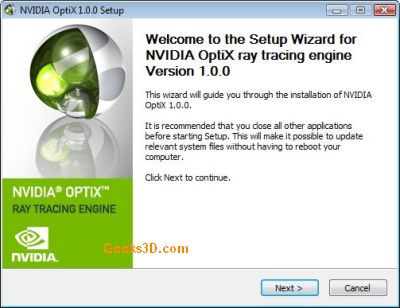NVIDIA OptiX SDK 0.5.5 Crack Free Download
- ecewtymonsrabska
- May 18, 2022
- 4 min read

NVIDIA OptiX SDK 0.5.5 Crack+ [32|64bit] NVIDIA OptiX SDK allows users to develop their applications • efficiently and to accelerate ray tracing tasks easily NVIDIA OptiX SDK consists of the following components The ray tracing engine • Includes a C-based programming system that enables the use of the raw ray tracing API for application developers. • A host-based API that makes it easy to integrate OptiX into CUDA applications Application Engine • Includes the OptiX engine, which supports for ray tracing algorithms • A CUDA kernel generator that enables the assignment of CUDA functions • A software layer that enables the safe and efficient sharing of data between OptiX and other CUDA applications Data Engine • Includes the data layers of the OptiX API, which supports scalable mesh generation and data analysis. OptiX SDK APIs • The OptiX API enables you to efficiently perform ray tracing algorithms and to access and manipulate the data needed by the algorithms. • The API consists of the following components: o Methods o Filters o Groups • For more information on the OptiX API, see the OptiX API documentation (Section 2.2). The following section describes each component of the OptiX SDK. 3 8. OptiX SDK Figure 2.3: CUDA C Runtime API Applications & Interfaces This section describes the application programming interfaces (APIs) of the OptiX SDK and the application programming interfaces (APIs) that OptiX SDK can be used with. The programming system in OptiX SDK is based on CUDA C, which includes the following features: · Direct compilation of CUDA C code into executable · High-level programming model · Portable programming system · Host-based API The programming system consists of the following components: · Compiler o A CUDA C front end, which allows you to write CUDA C code and then compile it directly into an executable · Runtime API o A CUDA C back end, which allows you to run your compiled CUDA C code Programming Features The programming system allows you to use a high-level programming model to write CUDA C code. The programming system supports the following features: · A high-level programming model for CUDA C o Blocks are independent units of CUDA code that allow you to reuse NVIDIA OptiX SDK 0.5.5 Activation Key 1a423ce670 NVIDIA OptiX SDK 0.5.5 Crack+ Registration Code [32|64bit] (April-2022) OptiX SDK is a ray tracing framework with a host-based API for CUDA applications, and a programming system based on CUDA C. It is designed to run on both NVIDIA Fermi and Kepler architectures, and can be used with any CUDA-compliant GPU. OptiX supports offloading ray tracing tasks to a NVIDIA GPU and memory that are shared with other CUDA applications. OptiX SDK enables software developers to accelerate as many ray tracing tasks as they want. API-to-programming system Layer OptiX SDK consists of three layers: 1. The kernel API 2. The programming system 3. The API for host-based CUDA applications This section will discuss each layer in turn. Kernel API The kernel API consists of API functions, data structures and a command line compiler. When a C or C++ application calls the OptiX SDK API functions, they automatically transfer all data information from host to the GPU. When C applications call the API functions, they transfer the same information to the programming system. The kernel API supports OpenGL, DirectX, and DirectX 11. API functions are available in both CUDA and CPU modes. In CUDA mode, the API functions are always available to the GPU, regardless of the current GPU context. In CPU mode, the API functions are only available to the GPU if an application creates a context on the GPU. The API is compatible with Fermi GPUs. This means that the API functions are always available on Fermi GPUs. OptiX SDK uses OpenGL shading language. It is an extension of OpenGL shading language that allows to compute ray tracing results within an OpenGL rendering context. OpenGL shading language is supported in CUDA and CPU modes. GPU Contexts This section will focus on GPU contexts and their management. In OptiX SDK, there are two modes of GPU context creation: · Device · Shared Devices are CUDA contexts. Shared contexts are shared between CUDA applications and OptiX SDK. When creating a device context, applications need to allocate the data that will be transferred from host to GPU. The data is held in a continuous buffer known as the buffer object. The buffer object is shared between GPU and application, and is always the same for a given context. To perform ray tracing tasks, the OptiX SDK API functions transfer data from the host to the GPU via What's New in the? System Requirements: To play The Elder Scrolls Online, the system requirements listed below are what are recommended. Depending on your computer's configuration, it may run the game differently. This is due to the fact that the game will also be updated regularly and as such may need more resources to run on a more modern machine. We recommend that the player use an existing version of the game to test the game against the system requirements before purchasing the game. Windows XP SP3: 1 GB RAM 2 GB Hard Drive Space DirectX 9.0c 2.4
Related links:
![MTremoloMB With License Code Download [Win/Mac]](https://static.wixstatic.com/media/10fd91_64854f56c7c94e1e954ff6e2c916b74b~mv2.jpeg/v1/fill/w_910,h_490,al_c,q_85,enc_avif,quality_auto/10fd91_64854f56c7c94e1e954ff6e2c916b74b~mv2.jpeg)


Comments